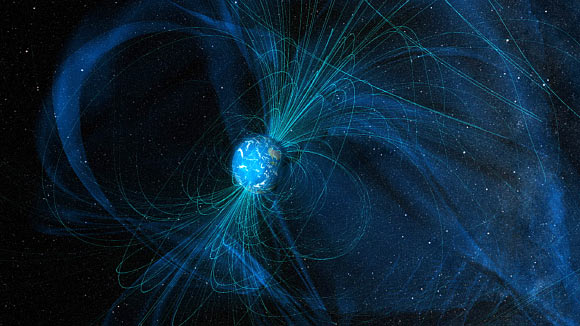Recovering ancient records of Earth’s magnetic field is challenging because the magnetization in rocks is often reset by heating during tectonic burial over their long and complex geological histories. Geoscientists from MIT and elsewhere show that rocks from the Isua Supracrustal Belt in West Greenland have experienced three thermal events throughout their geological history. The first event was the most significant, and heated the rocks up to 550 degrees Celsius around 3.7 billion years ago. The subsequent two events did not heat the rocks in the northernmost part of the area above 380 degrees Celsius. The authors use multiple lines of evidence to test this claim, including paleomagnetic field tests, the metamorphic mineral assemblages across the area, and the temperatures at which radiometric ages of the observed mineral populations are reset. They use these lines of evidence to argue that an ancient, 3.7-billion-year-old record of Earth’s magnetic field may be preserved in the banded iron formations in the northernmost part of the field area.
In the new study, University of Oxford’s Professor Claire Nichols and colleagues examined an ancient sequence of iron-containing rocks from Isua, Greenland.
Iron particles effectively act as tiny magnets that can record both magnetic field strength and direction when the process of crystallization locks them in place.
The researchers found that rocks dating from 3.7 billion years ago captured a magnetic field strength of at least 15 microtesla comparable to the modern magnetic field (30 microtesla).
These results provide the oldest estimate of the strength of Earth’s magnetic field derived from whole rock samples, which provide a more accurate and reliable assessment than previous studies which used individual crystals.
“Extracting reliable records from rocks this old is extremely challenging, and it was really exciting to see primary magnetic signals begin to emerge when we analyzed these samples in the lab,” Professor Nichols said.
“This is a really important step forward as we try and determine the role of the ancient magnetic field when life on Earth was first emerging.”
Whilst the magnetic field strength appears to have remained relatively constant, the solar wind is known to have been significantly stronger in the past.
This suggests that the protection of Earth’s surface from the solar wind has increased over time, which may have allowed life to move onto the continents and leave the protection of the oceans.
Earth’s magnetic field is generated by mixing of the molten iron in the fluid outer core, driven by buoyancy forces as the inner core solidifies, which create a dynamo.
During Earth’s early formation, the solid inner core had not yet formed, leaving open questions about how the early magnetic field was sustained.
These new results suggest the mechanism driving Earth’s early dynamo was similarly efficient to the solidification process that generates Earth’s magnetic field today.
Understanding how Earth’s magnetic field strength has varied over time is also key for determining when Earth’s inner, solid core began to form.
This will help us to understand how rapidly heat is escaping from Earth’s deep interior, which is key for understanding processes such as plate tectonics.
A significant challenge in reconstructing Earth’s magnetic field so far back in time is that any event which heats the rock can alter preserved signals.
Rocks in the Earth’s crust often have long and complex geological histories which erase previous magnetic field information.
However, the Isua Supracrustal Belt has a unique geology, sitting on top of thick continental crust which protects it from extensive tectonic activity and deformation.
This allowed the scientists to build a clear body of evidence supporting the existence of the magnetic field 3.7 billion years ago.
The results may also provide new insights into the role of our magnetic field in shaping the development of Earth’s atmosphere as we know it, particularly regarding atmospheric escape of gases.
“In the future, we hope to expand our knowledge of Earth’s magnetic field prior to the rise of oxygen in Earth’s atmosphere around 2.5 billion years ago by examining other ancient rock sequences in Canada, Australia, and South Africa,” the authors said.
“A better understanding of the ancient strength and variability of Earth’s magnetic field will help us to determine whether planetary magnetic fields are critical for hosting life on a planetary surface and their role in atmospheric evolution.”
The study was published in the Journal of Geophysical Research.
_____
Claire I. O. Nichols et al. 2024. Possible Eoarchean Records of the Geomagnetic Field Preserved in the Isua Supracrustal Belt, Southern West Greenland. Journal of Geophysical Research 129 (4): e2023JB027706; doi: 10.1029/2023JB027706


